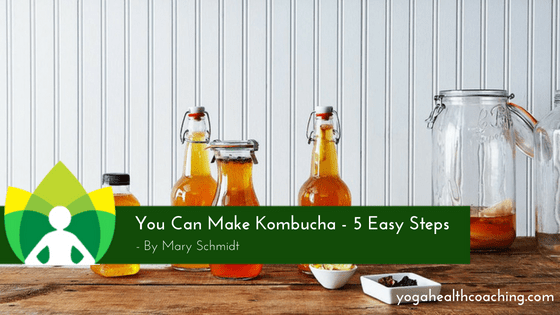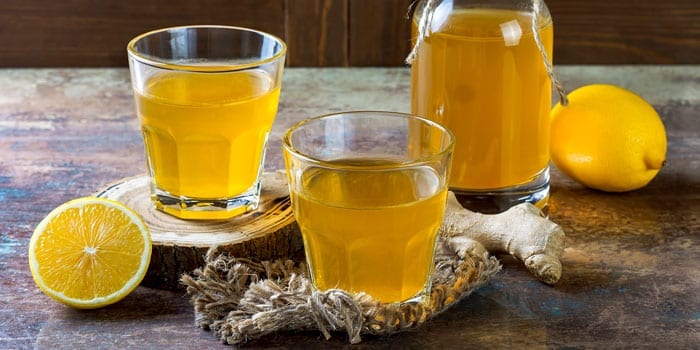
You Can Make Kombucha – 5 Easy Steps
I find making kombucha (a fermented tea) very rewarding as the preparation is easy and it is co$t effective versus buying a bottle at the store. I must admit that at first I was a bit turned off by the look of my scoby. But once I got over that, it was free sailing. First off, why kombucha? Kombucha Tea is an organic product that delivers probiotics to your gut. The benefits of drinking this tea include gut digestion, and improved liver health and immunity. One of the ways this is accomplished is by the release of glucuronic acids. These acids bind chemicals into a water soluble form that the kidneys can release. On the flip side of the coin, some people who already have digestive issues may not feel the same health benefits. More on that later.
What is a Scoby?
The official name is Symbiotic Culture of Bacteria and Yeast. When I watch my scoby in her jar she appears to me as the Mother Kapha of the fermentation process. She is pancake in shape and slow moving. Her job is to ingest sugar and expel organic acids, vitamins B & C and amino acids. She takes her time. The fermentation process cannot be rushed.
What supplies will I need?
-One gallon glass jar with lid (not ceramic, plastic or metal as they can leak chemicals)
-Scoby (should come with one cup of starter tea)
-Muslin, a coffee filter, or a clean kitchen towel and a rubber band (no cheesecloth as fruit flies can get through this material).
-15 cups filtered water (do not use tap)
-7 to 10 black tea bags (use organic black tea, not herbal or flavored tea as they contain oils that may harm your scoby)
-One cup of granulated sugar (white, not brown)
-Flip top bottles for a second fermentation (16 ounce – like Grolsch Beer)
-Various fruits, juices and/or herbs for flavoring
Step 1: Where do I get a scoby?
Kombuchkamp.com , Culturesforhealth.com , Amazon.com
Or from my scoby master: Sarah Hofeldt, hofesara@gamil.com or contact on facebook
Step 2: Tea Time (Sarah’s Recipe)
Bring 7 cups of filtered water to a boil. Add 7-10 black tea bags. Let steep 10-15 minutes then remove. Add one cup of granulated sugar and stir to dissolve. Let cool. Add 8 cups of filtered water to a one gallon glass jar. Add your sweet tea to the jar. Add scoby and one cup of starter tea. Cover the jar with a coffee filter and secure it with a rubber band (to keep bugs out). Please the jar in a warm spot (72-82 degrees, with lots of air flow), not in direct sunlight.
Step 3: Wait for It!
Your scoby will now go to work turning all that lovely sweet tea into kombucha. The process can take 5-30 days depending on the temperature of your storage area. I used a brown glass jar and kept my brew on the kitchen table, room temperature, out of direct sunlight. After a few days to a week you should notice a new “baby” scoby forming. It may grown on the underside of the mother or be detached. In a few more days/weeks you may be able to smell a faint sour odor, signaling that your brew is fermenting and is ready to sample. If the tea is still sweet allow more fermentation time. This step may not occur for a few weeks so be patient. My first batch took about 25 days. Good things are happening!
Step 4: The Bottling:
When your “booch” has reached the right proportion of sweet and sour, it is time to transfer your brew to bottles. You will have a new baby scoby too which you can either keep or give away to a gut-health-lovin’ friend by placing it in one cup of the starter tea you just made. You can use any clean glass bottle for this step. The best bottles have a flip-top closure (like Grolsch Beer). They work best at forming a tight seal, resulting in more fizz in your booch.
This is where you have the option of flavoring your kombucha with a ratio of 20% juice to 80% kombucha or other add-ins. Set your sealed, filled bottles out at room temperature for 2-4 days to promote carbonation and more complex flavors.
Favorite Flavor Combinations
Lemon & Ginger: ½ inch piece of diced ginger, juice of ½ a lemon, ring of half lemon ( if you are brave and love spice add a pinch of cayenne pepper)
Beet and strawberry: ⅛ cup of beet juice and 1-2 diced strawberries
Raspberry and Mint: ¼ cup raspberry and one mint leaf
Orange & Clove: Dice rind from ½ orange, one clove, juice from ½ an orange
*Stand-alone fresh fruit works too! Add ¼ cup to a 16 ounce bottle. Play, there is no right or wrong.
Step 5: Wait For It!
Store your bottles at room temperature for 2-4 days to improve the complexity of the brew, followed by a day or two in the fridge. To slow down the fermentation, store finished kombucha in the fridge.
Do’s:
-Wash your hands with filtered water or white vinegar, avoid using soap, as you prepare your kombucha
– Do throw away any batch that looks moldy, especially black.
Gut Health or Gut Bomb?
I find that drinking kombucha improves my digestion and decreases bloating. It is a wonderful transition beverage from fall/winter soups and broths to spring/summer water and teas. Kombucha is also a wonderful alternative to buying soda for children as it does not contain any artificial chemicals or dyes. I have been told by a few local brewers that their interest in brewing kombucha began with looking for alternative beverages for their children who have diabetes, autism and learning disabilities.
If you have not yet played with preparing fermented foods, for you first attempt I highly recommend taking a class and being mentored by your teacher. Your teacher will help you through the fermentation process and develop the “taste” (vinegar v sweet). This is an important step to know when your booch is ready for the second fermentation. From that point on it should be smooth sailing.
Is Kombucha right for everyone? Some critics warn against drinking Kombucha Tea while you are pregnant or breastfeeding, as possible side effects include upset stomachs and allergic reactions. When breastfeeding some note that their baby was “cranking” during feeding. Additionally, making sure you are brewing your kombucha under sterile conditions is especially important if you are pregnant. Due to kombuchas claimed detoxifying effects, breastfeeding women should also use caution if they are not properly hydrated as toxins can come out the the skin and possibly breast milk. The overall advice from this camp was if you have never tried it before, pregnancy is not the best time to begin. Vatas and also Pittas, especially in the hot summer months, may also want to proceed with caution, as some claim it can cause bloating and stomach upset. With Kaphas, it is smooth sailing.. 🙂 When all is said and done, decide for yourself if you want to experiment or not.
I make kombucha because I enjoy making it, the taste and rewarding health benefits. I can only write from personal experience, and if you are curious, make a batch for yourself. Get yourself a teacher and a scoby and start brewing!




